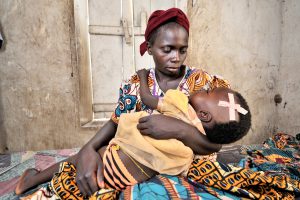Mission hospital dedicated to caring for mothers
The first missionaries sent to Africa by the Methodist Episcopal Church, South (MECS), made Wembo Nyama their home base in what was then a colony of Belgium, “Congo Belge.” In each mission station it founded, the MECS sent a missionary director and a women’s work director, usually a married couple, along with a teacher and a nurse. The teacher and nurse were supplied by the MECS Woman’s Missionary Council, a predecessor of United Methodist Women. A doctor was appointed to set up a dispensary and hospital after the station was up and running.
The work in Minga began after a false start in Lubefu in 1917. The Rev. L. M. Kinman had established the work in Lubefu, but the whole station had to be moved because too many people and buildings were struck by lightning on Lubefu Hill. In 1922, Minga was established, a few miles west of Lubefu. In 1920, Mary Flora Foreman, an RN from Arkansas, began work in the Wembo Nyama hospital. Two missionary couples, the Bush and Ware families, were appointed to Minga, while Christine Allen accepted the teaching assignment. After a few years, Flora Foreman, as she was known, moved to Minga to establish medical work.
The MECS had trouble finding a doctor for Minga, but in 1928, the first full-time doctor arrived to set up the hospital. Dr. Janet Miller, who had worked for 12 years prior as a missionary at the Margaret Williamson Hospital in Shanghai, China, was eager to start work in Africa. In an article in the 1928 Missionary Voice, she says “Here in the heart of Central Africa, I am in a little Christian settlement of 600 souls. Day by day, they are patiently taught the 'things of God.' They are learning to take responsibility in a most surprising way. One boy of 14 is holding a position of great responsibility in the mission, and we were told of others who could be trusted to do faithful service…The prospect for the future seems very bright indeed to me from my first impression.” It was a big change and very long journey from China.
Dr. Janet Miller, from North Carolina, worked with Flora Foreman to establish medical work at the station. The mission board, however, preferred a male doctor in the position, believing the Congo was too dangerous an assignment for a single woman. Dr. Miller returned to the U.S. in 1931, replaced by Dr. W. S. Hughlett, but she wrote a book called Jungles Preferred, which pretty much sums up her thoughts on the mission board’s decision.
The Women’s Missionary Council of the Woman’s Division had no such trepidation about sending its missionaries to the Congo. Flora Foreman, born on a farm in Arkansas, served at Minga station for 31 years, retiring in 1953. She never married. One of the duties Foreman performed thousands of times was the delivery of babies. She would often venture into the villages by bike to check on her charges, giving prenatal care and checking for sleeping sickness, the deadly parasite carried by the tsetse fly. Dr. Jordan Grooms, from Polk Street Methodist Church in Amarillo, Texas, where Foreman settled in retirement, said at her memorial service that even in the in the last weeks of her life in 1964, Flora was praying for more doctors to staff the clinics and hospital in the Congo.

Today, Flora Foreman’s prayers have been answered, in part by the very medical schools and churches that she helped to establish. All of the Methodist medical institutions in the Democratic Republic of the Congo (DRC) are staffed by Congolese men and women. The hospital at Minga is under the care of its director. Besides two doctors, the 90-bed hospital is supported by a staff of 45 nurses and technicians and 12 administrators. The hospital serves a population of roughly 130,000, most of whom depend upon subsistence fishing and farming and petty trade. On average, the hospital attends 500 patients per year. The medical work is jointly administered by The United Methodist Church of the Congo and the Congolese government.
Minga is near a mining area and it suffered much damage during the recent civil war in the DRC. The hospital needs major help. During the war, the government established a military base in the area, making the situation for women in Minga much more difficult. Rape is used as a weapon of war in the DR Congo. Rates of HIV/AIDS and other diseases have been on the rise in the area, so the hospital is sorely needed.
By Christie R. House, editor of New World Outlook magazine.




